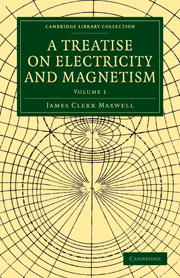Book contents
- Frontmatter
- PREFACE
- Contents
- ELECTRICITY AND MAGNETISM
- PRELIMINARY
- PART I ELECTROSTATICS
- PART II ELECTROKINEMATICS
- CHAPTER I THE ELECTRIC CURRENT
- CHAPTER II CONDUCTION AND RESISTANCE
- CHAPTER III ELECTROMOTIVE FORCE BETWEEN BODIES IN CONTACT
- CHAPTER IV ELECTROLYSIS
- CHAPTER V ELECTROLYTIC POLARIZATION
- CHAPTER VI MATHEMATICAL THEORY OF THE DISTRIBUTION OF ELECTRIC CURRENTS
- CHAPTER VII CONDUCTION IN THREE DIMENSIONS
- CHAPTER VIII RESISTANCE AND CONDUCTIVITY IN THREE DIMENSIONS
- CHAPTER IX CONDUCTION THROUGH HETEROGENEOUS MEDIA
- CHAPTER X CONDUCTION IN DIELECTRICS
- CHAPTER XI MEASUREMENT OF THE ELECTRIC RESISTANCE OF CONDUCTORS
- CHAPTER XII ELECTRIC RESISTANCE OF SUBSTANCES
- Plate section
CHAPTER XII - ELECTRIC RESISTANCE OF SUBSTANCES
Published online by Cambridge University Press: 05 July 2011
- Frontmatter
- PREFACE
- Contents
- ELECTRICITY AND MAGNETISM
- PRELIMINARY
- PART I ELECTROSTATICS
- PART II ELECTROKINEMATICS
- CHAPTER I THE ELECTRIC CURRENT
- CHAPTER II CONDUCTION AND RESISTANCE
- CHAPTER III ELECTROMOTIVE FORCE BETWEEN BODIES IN CONTACT
- CHAPTER IV ELECTROLYSIS
- CHAPTER V ELECTROLYTIC POLARIZATION
- CHAPTER VI MATHEMATICAL THEORY OF THE DISTRIBUTION OF ELECTRIC CURRENTS
- CHAPTER VII CONDUCTION IN THREE DIMENSIONS
- CHAPTER VIII RESISTANCE AND CONDUCTIVITY IN THREE DIMENSIONS
- CHAPTER IX CONDUCTION THROUGH HETEROGENEOUS MEDIA
- CHAPTER X CONDUCTION IN DIELECTRICS
- CHAPTER XI MEASUREMENT OF THE ELECTRIC RESISTANCE OF CONDUCTORS
- CHAPTER XII ELECTRIC RESISTANCE OF SUBSTANCES
- Plate section
Summary
359.] There are three classes in which we may place different substances in relation to the passage of electricity through them.
The first class contains all the metals and their alloys, some sulphurets, and other compounds containing metals, to which we must add carbon in the form of gas-coke, and selenium in the crystalline form.
In all these substances conduction takes place without any decomposition, or alteration of the chemical nature of the substance, either in its interior or where the current enters and leaves the body. In all of them the resistance increases as the temperature rises.
The second class consists of substances which are called electrolytes, because the current is associated with a decomposition of the substance into two components which appear at the electrodes. As a rule a substance is an electrolyte only when in the liquid form, though certain colloid substances, such as glass at 100°C, which are apparently solid, are electrolytes. It would appear from the experiments of Sir B. C. Brodie that certain gases are capable of electrolysis by a powerful electromotive force.
In all substances which conduct by electrolysis the resistance diminishes as the temperature rises.
The third class consists of substances the resistance of which is so great that it is only by the most refined methods that the passage of electricity through them can be detected. These are called Dielectrics.
- Type
- Chapter
- Information
- A Treatise on Electricity and Magnetism , pp. 415 - 426Publisher: Cambridge University PressPrint publication year: 2010First published in: 1873



